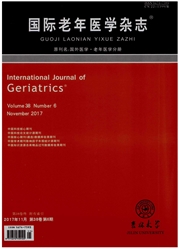

 中文摘要:
中文摘要:
目的 探讨约束决策轮及等级在重症监护室( intensive care unit , ICU )危重症意识障碍患者中的应用效果.方法 选择2012年7月~2013年12月本科室收治的危重症意识障碍留置管道并有拔管风险,可能需采用约束带约束肢体的患者254例,按住院先后顺序编号,根据随机数字表法将患者分为对照组 125例与观察组129例. 对照组患者参照《约束护理单》评估后进行约束;观察组患者采用约束决策轮及等级评估后进行约束. 比较两组患者身体约束使用率、非计划性拔管率、约束部位皮肤异常发生率. 结果 观察组患者身体约束使用率明显低于对照组,两组比较,P<0.01,差异具有统计学意义;两组患者非计划性拔管率比较,P>0.05,差异无统计学意义;两组患者约束期间均无发生皮肤异常情况.结论 约束决策轮及等级在ICU危重症意识障碍患者中的应用,可减少患者不必要约束或约束不及时,保证患者安全,提高护理安全管理质量.
 英文摘要:
英文摘要:
Objective To investigate the effect of restriction decision wheel and grade ICU patients with critical consciousness disorder. Methods Two hundred and fifty four patients in ICU with critical consciousness disorder from July to December 2012, who were intubated and constrained with their limbs due to the risk of unexpected extubation, were divided into the control group (n=125) and the experiment group (n=129), according to registration sequence. The former were constrained to their limbs after evaluation referring to the constraint nursing form and the latter was constrained by using the constraint decision-making wheel and grade. The two groups were compared in terms of restraint rate, unplanned extubation rate, and incidence of skin abnormality. Results The restraint rate of the observation group was significantly lower than that of the control group (P〈0.01). There was no incidence of abnormal skin in the two groups. There was no significance in the rate of unplanned extubation between the two groups (P〉0.05). Conclusion Constraints decision making wheel and grade is effective in ensuring patients'safety and improving the quality of nursing safety management by reducing unnecessary constraints or the incidence of delayed constraints.
 同期刊论文项目
同期刊论文项目
 同项目期刊论文
同项目期刊论文
 MicroRNA transcriptome analysis identifies miR-365 as a novel negative regulator of cell proliferati
MicroRNA transcriptome analysis identifies miR-365 as a novel negative regulator of cell proliferati PMT1 deficiency enhances basal UPR activity and extends replicative lifespan of Saccharomyces cerevi
PMT1 deficiency enhances basal UPR activity and extends replicative lifespan of Saccharomyces cerevi 期刊信息
期刊信息
